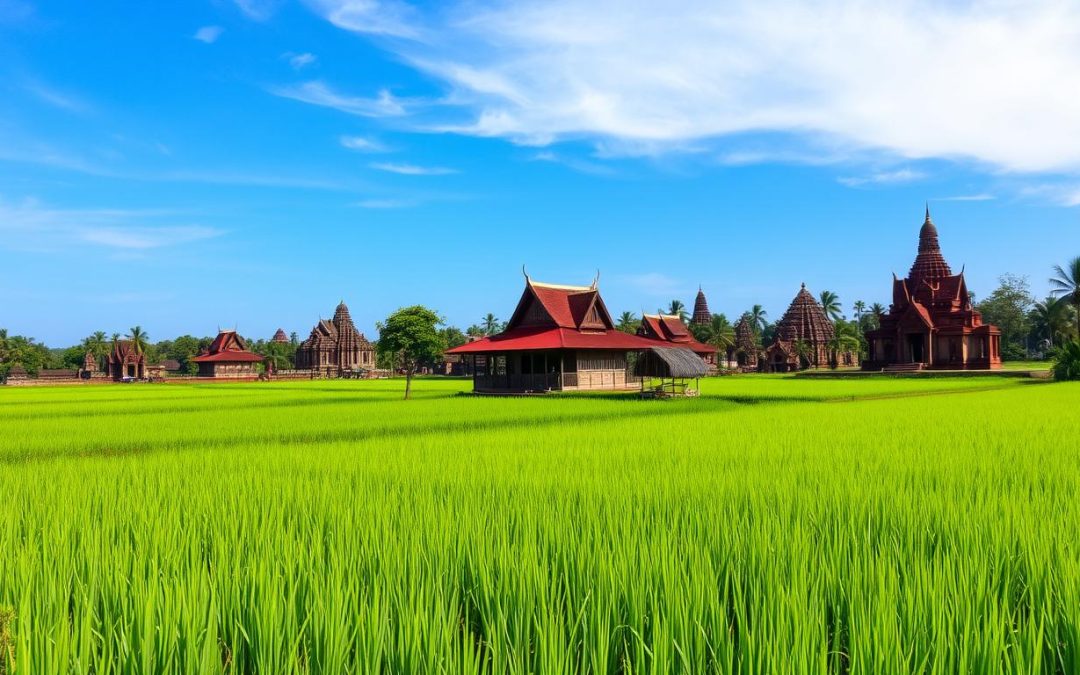Ever wondered how a small Southeast Asian nation handles its many languages? Cambodia is a great example. Here, the Khmer language is the main one, but many others also exist and change.
Cambodia has about 13 million people. The official language, Khmer, is spoken by almost 90% of them. It’s used everywhere, from cities to countryside.
Looking into Cambodia’s languages shows more than just words. It shows the country’s culture, history, and how people interact. From Phnom Penh’s busy streets to the quiet countryside, language tells a story of strength and change.
Key Takeaways
- Khmer is the official national language of Cambodia
- Approximately 90% of Cambodians speak Khmer
- English has replaced French as the dominant foreign language
- Multiple minority languages coexist within the country
- Language reflects Cambodia’s complex cultural heritage
Understanding Khmer: Cambodia’s Official Language
The Khmer language is at the heart of Cambodia’s culture. It connects millions of people across the nation. Khmer is more than a way to talk; it’s a symbol of Cambodia’s rich heritage.
Historical Development of Khmer
The Khmer language started in the 7th century CE. It has gone through many changes. Sanskrit and Pali, ancient languages, greatly influenced Khmer, especially in royal and religious areas.
- Oldest written monument discovered in Takeo province (611 AD)
- Influenced by Indian Brahmi script
- Part of the Austroasiatic language family
Linguistic Features and Structure
Khmer has a unique way of speaking. Its writing system is especially interesting. It has:
- 33 consonants
- 24 vowels
- 14 free vowels
- Subject-predicate-object sentence structure
“Language is the road map of a culture. It tells you where its people come from and where they are going.” – Rita Mae Brown
Modern Usage and Importance
Today, Khmer is spoken by about 16 million people. This is about 96% of Cambodia’s population. It’s key in education, law, and government. It helps keep the culture and unity strong.
| Language Metric | Details |
|---|---|
| Total Speakers | 16 million |
| Percentage of Population | 96% |
| Language Classification | Austroasiatic |
Learning Khmer lets us see into Cambodia’s heart. It shows us its history, culture, and its story of diversity and strength.
The Evolution of Language Diversity in Cambodia
Cambodia’s language scene is a story of cultural change. For centuries, many languages have mixed together here. This mix comes from migrations, historical events, and cultural exchanges.
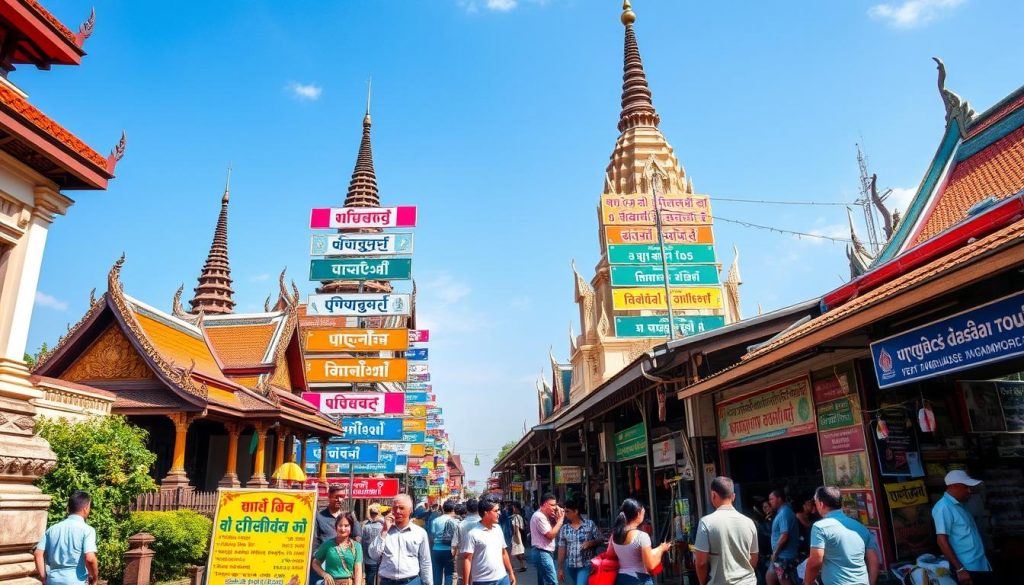
The roots of language diversity in Cambodia go back a long way. Indigenous languages and outside influences have shaped how people talk. The Austroasiatic language families were key in setting up the base for languages here.
- Ancient Khmer empires introduced sophisticated language structures
- Hindu and Buddhist traditions significantly impacted linguistic development
- Colonial periods brought additional language influences
Khmer is the main language, spoken by almost 90% of people. Linguistic diversity grew as Cambodia interacted with other countries and people moved here. Minority languages, especially in border areas, add to the mix of languages.
“Language is the roadmap of a culture. It tells you where its people come from and where they are going.” – Rita Mae Brown
Minority languages like Bunong and Cham are key parts of Cambodia’s language history. These languages are mainly found in certain provinces. They show the detailed ways people have communicated over time.
To understand Cambodia’s language diversity, we must see the links between history, culture, and society. These connections have shaped how people talk in the region.
Cambodia’s Language Demographics and Distribution
Cambodia’s language scene is both diverse and rich. With a population of 16,946,438, it shows a wide range of languages. This diversity is seen in both cities and rural areas.
The Khmer language is at the heart of Cambodia’s language use. About 90% of people speak Khmer first. This makes Khmer a key part of Cambodian identity.
Urban vs Rural Language Usage
Language use changes a lot between cities and countryside. In big cities like Phnom Penh, you find more languages:
- Urban areas have more people speaking different languages
- There’s more chance to hear minority languages
- Foreign language classes are more common
Regional Language Variations
Beyond Khmer, Cambodia is home to many minority languages. These languages add to the country’s rich communication mix:
- Cham language is spoken by about 220,000 people
- Vietnamese is also spoken by many
- Indigenous languages are found in places like Ratanakiri Province
Population Statistics by Language Group
The numbers show how language education and diversity play out:
- Khmer is spoken by 95% of people
- French is spoken by 3%
- English is spoken by 2%
- Over 20 indigenous languages are also spoken
“Language is the roadmap of a culture. It tells you where its people come from and where they are going.” – Rita Mae Brown
Knowing about these language numbers helps us see Cambodia’s rich language world. It shows how culture and history shape how we talk to each other.
Cultural Impact of Multilingualism in Cambodia
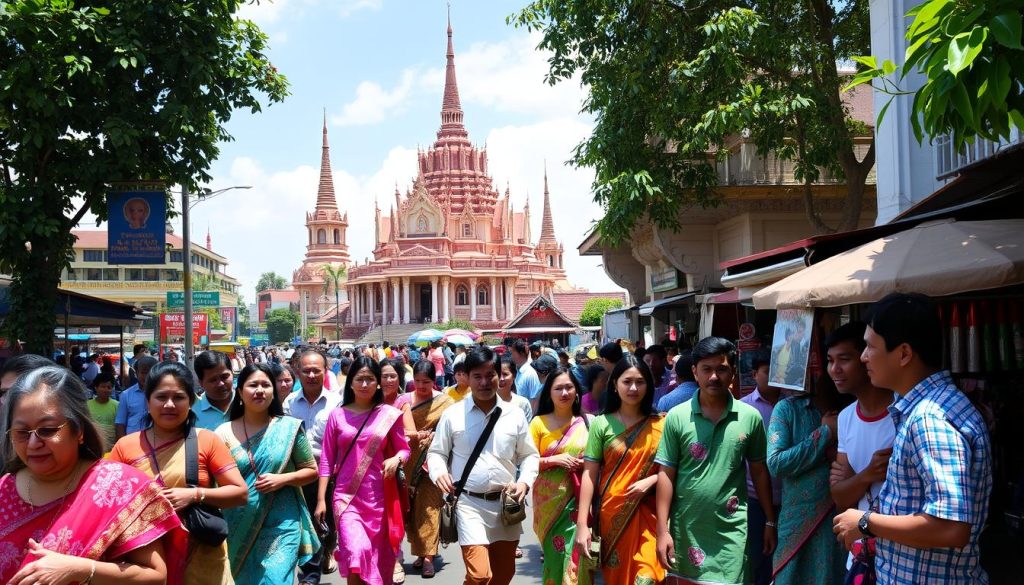
Cambodia’s language scene is a colorful mix of cultures. It’s more than just talking to each other. It shows the complex social and cultural life of the country.
The language policy of Cambodia tells its history. It shows how languages have shaped the nation’s identity. In places like Siem Reap, people show amazing skill in speaking many languages.
“Language is the roadmap of a culture. It tells you where its people come from and where they are going.” – Rita Mae Brown
- Khmer is the official language, keeping the national identity strong
- In tourist spots, people speak many languages
- Children often learn to speak many languages
- Global trends make language diversity grow
In places popular with tourists, speaking many languages is key to survival. Shopkeepers and tuk-tuk drivers speak Mandarin, Korean, English, and Khmer. This shows how important speaking many languages is for work and social life.
| Language | Usage Context | Cultural Significance |
|---|---|---|
| Khmer | Official communication | National cultural core |
| English | Tourism, business | Global connectivity |
| Chinese | Trade, tourism | Economic interaction |
Understanding Cambodia’s language scene shows that multilingualism is more than words. It’s about connecting cultures, understanding each other, and opening up new chances for growth.
Foreign Language Influence on Cambodian Society
Cambodia’s language scene has changed a lot because of foreign languages. This change shows how languages mix and adapt over time.
French Colonial Legacy
The French ruled Cambodia for 90 years, making French a big part of life. It was used in schools, government, and culture. But, since the early 2000s, French has become less common.
- French was the primary administrative language
- Influenced educational systems and bureaucratic structures
- Approximately 15% of the population spoke French as a foreign language
Rise of English Language
English has become the main foreign language in Cambodia since 1993. Now, most young people prefer English or Chinese over French.
| Language | Usage Percentage | Primary Sectors |
|---|---|---|
| English | 5% | Business, Diplomacy, Education |
| French | 15% | Older Generation, Academic Circles |
Impact on Education and Business
Knowing a language is key for jobs. In the last 20 years, speaking English, French, or Chinese helped people get jobs. Now, there’s a need for both Khmer and foreign language skills.
“Language is the roadmap of a culture. It tells you where its people come from and where they are going.” – Rita Mae Brown
The language policy in Cambodia is changing. It’s trying to keep the national identity while also meeting global needs.
Cambodia’s Official and Widely Spoken Languages: A Closer Look
In Cambodia, you’ll find a rich mix of languages, with Khmer at the center. It’s the official language and is spoken by almost 90% of people. Khmer is the core of Cambodia’s culture and communication.
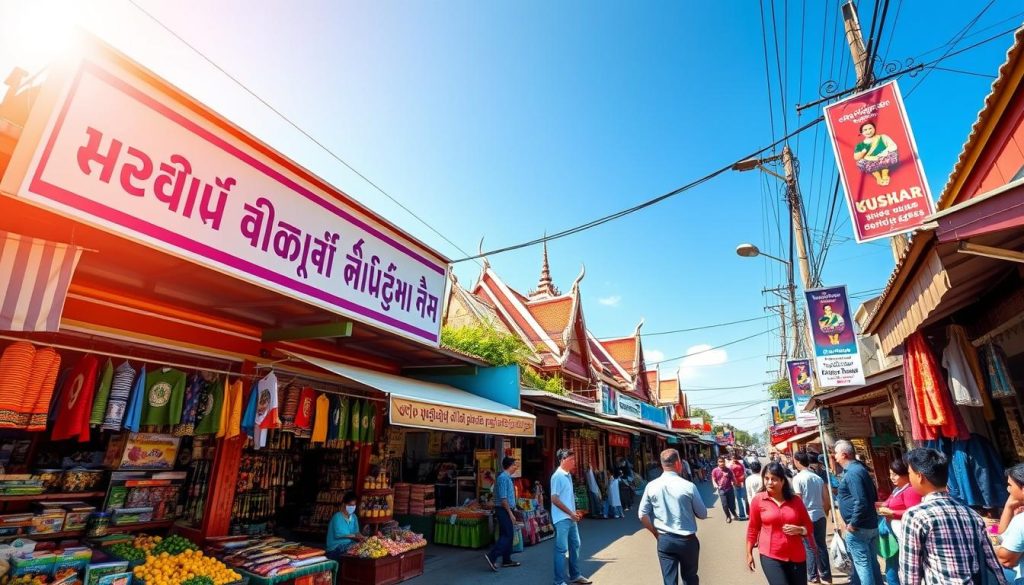
Exploring Cambodia’s languages shows us its complex beauty. Here are some key facts about Khmer:
- Part of the Mon Khmer language family
- Contains 44 consonants (33 regular symbols)
- Features 24 dependent vowel symbols
- Includes six distinct tones
The Phnom Penh dialect is the most well-known and widely understood. Linguistic variations are seen between cities and rural areas. These differences affect how words are pronounced and used.
“Language is the roadmap of a culture. It tells you where its people come from and where they are going.” – Rita Mae Brown
Cambodia also values speaking many languages. English and French are key in work and school. About 15% speak French, and 5% speak English.
Minority languages add to Cambodia’s language diversity. Groups like the Bunong, Kra, and Cham keep their languages alive. They live mainly in places like Mondulkiri, Ratanakiri, and Kampot.
Indigenous and Minority Languages of Cambodia
Cambodia’s language scene is full of variety, with more than just Khmer. The country is home to many minority languages and indigenous groups. These show off Cambodia’s rich cultural background.
About 22 different indigenous peoples live in Cambodia, as recent censuses show. These languages are mainly found in Ratanakiri and Mondulkiri provinces. There, 120,000 to 200,000 indigenous people speak these languages.
Cham Language Communities
The Cham people are a big part of Cambodia’s minority languages. Their language, from the Austronesian family, has a long history. It’s key to Cambodia’s language mix, but keeping it alive is hard.
Vietnamese Speaking Populations
Vietnamese speakers are also a big part of Cambodia’s language scene. They live in border areas and cities. They add to the country’s mix of languages.
Other Ethnic Language Groups
- Largest indigenous language communities:
- Kuy
- Mnong
- Stieng
- Brao
- Tampuan
- Language families represented:
- Mon-Khmer languages
- Austronesian languages
These languages face big challenges, like not enough education and the risk of disappearing. Only 38 indigenous groups have land rights. This shows the fight for cultural recognition and saving their languages.
“Language is the road map of a culture. It tells you where its people come from and where they are going.” – Rita Mae Brown
It’s important to protect these minority languages. This helps keep Cambodia’s rich language and cultural heritage alive.
Language Education and Policy in Modern Cambodia
Cambodia’s language education scene is shaped by history, culture, and economy. The main language taught is Khmer. Schools also try to teach in many languages.
The government’s efforts in language education show how they plan for the country’s future:
- Khmer is the main language taught in public schools
- English and French are taught as foreign languages
- Bilingual education programs help minority language groups
Recent data shows big challenges in teaching languages:
| Language Proficiency Group | Percentage |
|---|---|
| Children (7-14) proficient in Khmer | 93.8% |
| Youth (15-24) proficient in Khmer | 87.6% |
| Children knowing Khmer and English | 3.4% |
The policy tries to keep cultural identity while also teaching global languages. Urban areas show more people speaking many languages. This creates gaps in education that officials are working to fix.
“Education is the foundation of our national development strategy” – Cambodian Education Official
The big challenge is to make language education inclusive. It must help all people, especially those from minority groups. At the same time, Khmer should stay the main language taught.
Business and Professional Language Usage
Language is key in Cambodia’s work world, guiding how people talk in different fields. As the economy grows, knowing how to use language well is more important than ever for businesses and workers.
In Cambodia’s business world, speaking many languages opens up new chances. Khmer is the main language for local business, but English is key for global trade and work.
Language in Commerce
Cambodian businesses see the value in speaking many languages. Here are some trends:
- Khmer is the go-to for local talks
- English is the top choice for global business
- French still has a strong spot in some fields
Professional Communication Trends
The way people talk at work in Cambodia is changing fast. Knowing English well is a big plus for jobs in:
- Tourism
- International trade
- Technology
- Multinational companies
“Language skills are now as critical as technical expertise in Cambodia’s evolving job market.”
Language Skill Demand
Employers in Cambodia want workers who can speak many languages. Being able to talk in different languages can really help your career.
| Language | Professional Importance | Business Sectors |
|---|---|---|
| English | High | International Trade, Tourism, Technology |
| Khmer | Essential | Local Commerce, Government, Education |
| French | Moderate | Diplomatic, Historical Sectors |
As Cambodia joins the global market, those who speak many languages will have a big edge.
Language Preservation Efforts and Challenges
Cambodia is working hard to keep its many languages alive. It has 24 minority languages besides Khmer. But, money issues and past traumas make it tough.
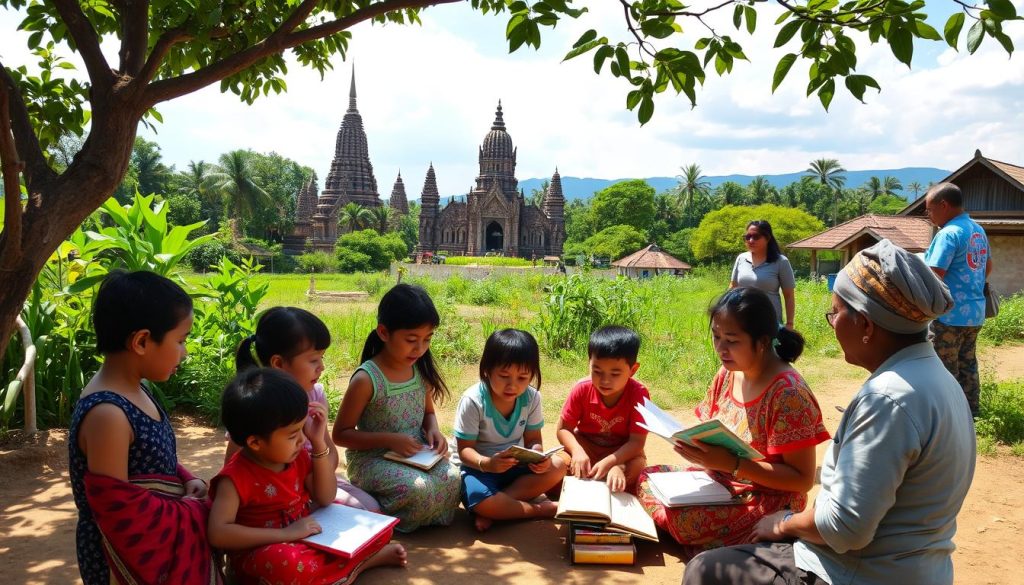
Keeping these languages alive needs many steps. Important actions include:
- Multilingual education programs
- Community-based language documentation
- Professional training for educators
- Collaborative efforts with international organizations
CARE Cambodia is leading the way. They focus on early learning and primary education. For over 20 years, they’ve worked with communities to save languages.
“Language is the roadmap of a culture. It tells you where its people come from and where they are going.” – Rita Mae Brown
But, there are big hurdles. About 19 languages might disappear soon. The S’aoch community is a sad example, with only 110 people left and just 10 fluent speakers.
The government and others are trying to help. The Education Ministry is adding four minority languages to schools. But, it’s a slow process. Money problems affect language efforts, with many people very poor.
It’s important to know about these efforts. Saving a language means keeping a culture and history alive for the future.
The Future of Languages in Cambodia
Cambodia’s language scene is changing fast, thanks to new tech and global links. As the country gets more digital, how we learn and use languages is changing. This will greatly impact how we talk to each other in the next few years.
New language trends in Cambodia are really interesting. Digital tools are changing how people use languages. This opens up new ways for people to connect through language.
Emerging Language Trends
Several key trends are changing Cambodia’s language world:
- English is becoming more important in cities.
- More people are learning languages online.
- Workplaces are getting more multilingual.
Digital Language Integration
Technology is helping bridge language gaps in new ways:
- Apps for learning languages on the go.
- Tools for instant translation.
- Language options on social media.
“Language is the roadmap of a culture. It tells you where its people come from and where they are going.” – Rita Mae Brown
The future of language policy in Cambodia looks promising. It will be a place where Khmer is key but also open to the world.
By 2030, about 30% of Cambodians might speak English. This shows Cambodia’s dedication to language diversity and connecting with the world.
Conclusion
Cambodia’s language diversity is a treasure trove of cultural heritage. The official language, Khmer, is at the core of the nation’s identity. It is spoken by about 17 million people, connecting cities and countryside.
Exploring Cambodia’s language scene shows a vibrant world. With a population expected to reach 17,578,000 by 2025, the country’s language skills are impressive. The mix of Khmer and minority languages shows Cambodia’s diverse society.
Learning about Cambodia’s languages gives us a deeper look into its culture. From the Phnom Penh dialect to local variations, language tells the nation’s story. As Cambodia grows, its language heritage symbolizes unity and pride.
When you dive into Cambodian culture, remember language is a bridge to the past, present, and future. Keeping language diversity alive will shape Cambodia’s identity for years to come.
The above is subject to change.
Check back often to TRAVEL.COM for the latest travel tips and deals.
Here are some Tours & Sightseeing suggestions that might pique your interests!
